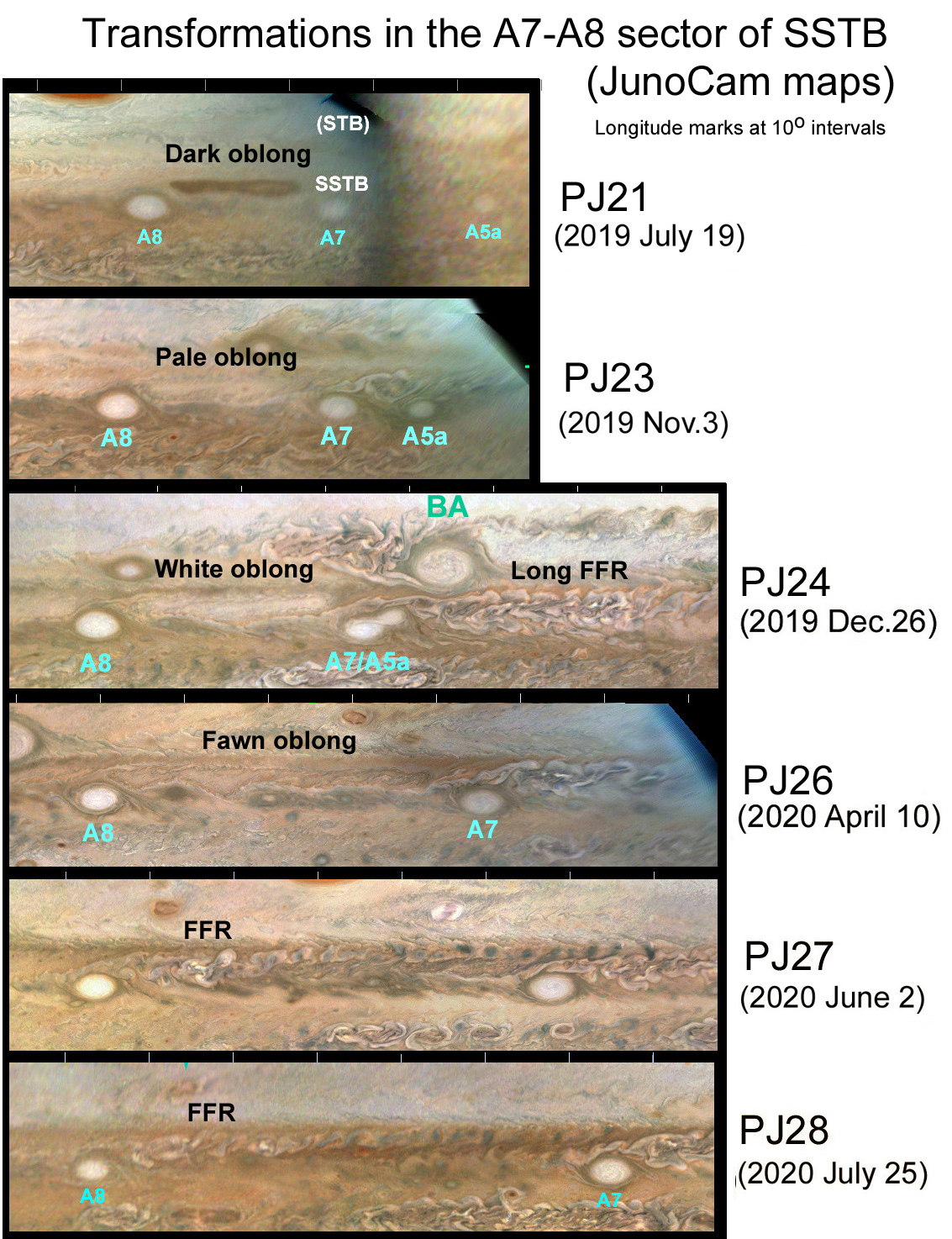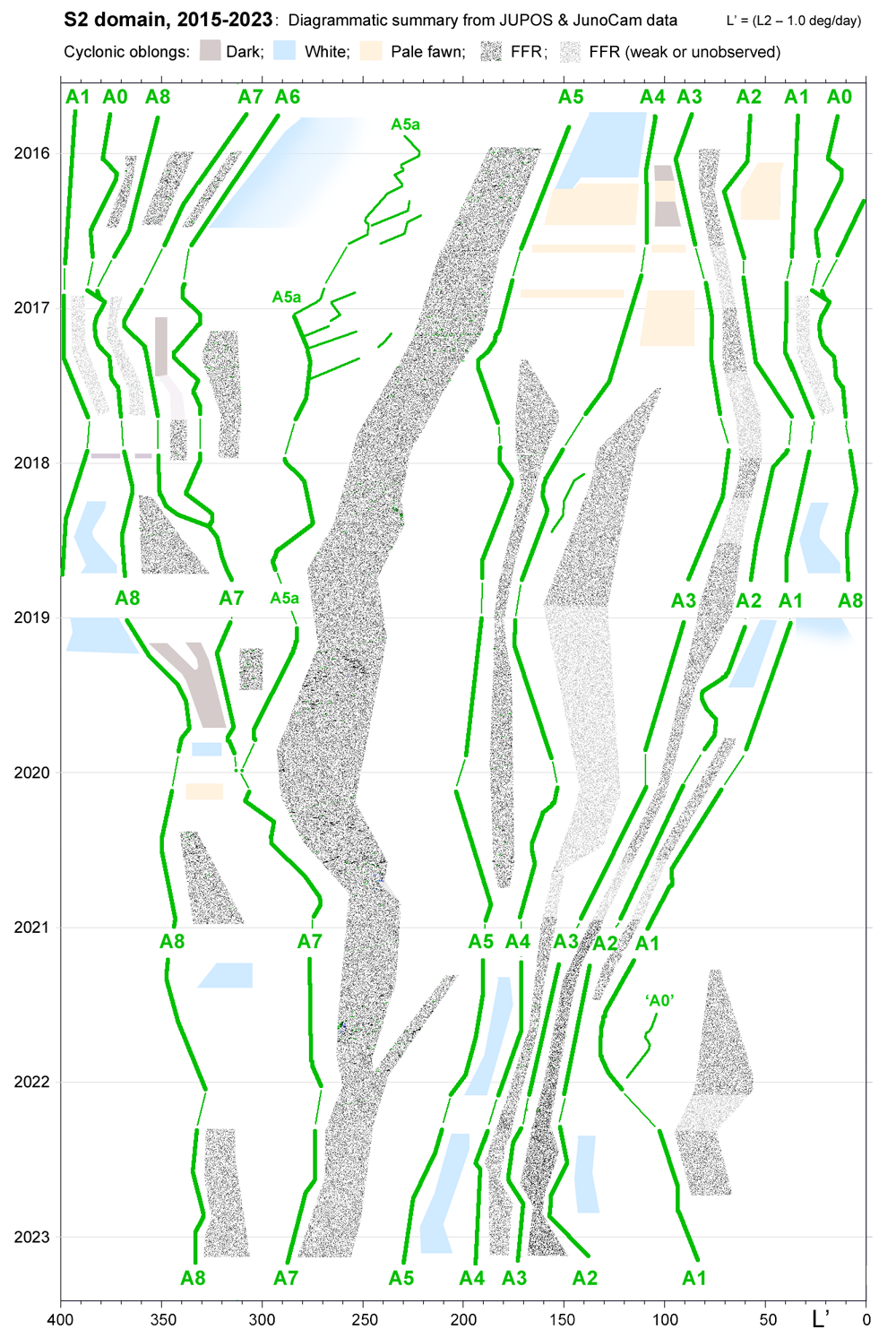Longevity of cyclonic formations in Jupiter’s S2 (South South Temperate) Domain
- 1British Astronomical Association, London, UK (jrogers11@btinternet.com)
- 2Planetary Science Institute, Tucson, AZ, USA
- 3Independent scholar, Stuttgart, Germany
- 4Jet Propulsion Lab, California Institute of Technology, Pasadena, CA, USA
- 5JUPOS team
By combining data from JunoCam and ground-based images, we present a history of the large-scale cyclonic structures in Jupiter’s S2 domain spanning 7.5 years, thus establishing the range of lifetimes of chaotic formations for the first time. The S2 domain lies between the prograde jets at 36ºS (planetographic) and 43ºS, encompassing the traditionally named South South Temperate Belt (SSTB) and Zone (SSTZ). The most distinctive features here are 6 to 9 long-lived anticyclonic white ovals (AWOs) [ref.1]. Between them are a number of cyclonic circulations, which have been well characterised by short-term imaging from previous spacecraft, but could not be comprehensively followed because many of them were not well resolved in ground-based images. Images from JunoCam now enable most or all of them to be characterised on each of Juno’s orbits (e.g. Figure 1), and modern amateur imaging can resolve them more frequently for several months around Jupiter’s oppositions (e.g. Figure 2). Thus we can now document these cyclonic features in the SSTB continuously from 2015 to 2023, along with high-resolution views of them from JunoCam.
They fall into three categories: (i) Cyclonic dark spots or oblongs, often dark brown. (ii) Cylonic white oblongs (CWOs). (iii) Folded filamentary regions (FFRs).
The first two are closed circulations; FFRs are more chaotic and may emit disturbance to east and west. The JunoCam images also sometimes reveal long, pale fawn-coloured sectors of the SSTB that resemble CWOs in structure and are probably closed circulations. In ground-based images these may appear as a dull-white CWO (because JunoCam is more sensitive to blue absorption than typical amateur filters) or as a nondescript sector of the SSTB.
A diagrammatic chart showing the history of these types of cyclonic feature is in Figure 3. Any of them can last for as little as ~4 months. CWOs often last longer, ranging up to 2.8 years in this survey, and up to nearly 6 years in earlier ground-based records [ref.1]. FFRs also have a large range of lifetimes, although they may sometimes be temporarily weak; two have existed for the full duration of this survey (>7.5 years). Some sectors (delimited by AWOs) have shown repeated changes between the cyclonic types: any of three types can convert into any other over a matter of months, sometimes via a pale ochre oblong as intermediate (Figures 1 & 4).
Dark oblongs may form when a FFR becomes inactive. Dark spots or oblongs often end their lives by becoming redder and then lighter in colour, sometimes becoming white. Some of these dark spots are very small and can turn into white ovals that do not expand; these are not considered further here. Longer structures can turn into light oblongs which expand in longitude as CWOs.
CWOs sometimes brighten rapidly in their early stages; a new one in 2018 was very bright white and also bright in the 889-nm methane band, as was one in 2013 (just before this survey period). This was not a transient convective plume, but static methane-brightness of the white oblong, which is a very rare condition for a cyclonic oval on Jupiter. CWOs always expand in longitude during their lifetime. Four CWOs whose later stages were observed by JunoCam all ended gradually, changing from white to dull white or fawn, sometimes being very long but retaining the loop form suggesting continuing circulation; sometimes it was also visibly disturbed. This stage lasted for up to a year; then in three cases it was terminated by a new FFR developing within its former boundaries.
New FFRs have appeared and disappeared about once a year. A young FFR is usually small and expands, though they do not grow indefinitely. We have never noted an especially bright convective outbreak initiating a FFR, though many could have gone undetected; and only one JunoCam observation of a young one showed it as methane-bright.
All three types are equivalent to cyclonic features in most other domains, although their relative size and importance vary. [See our abstract in the ODAA1 session for the STB.] For example, dark spots or oblongs are smaller versions of ‘barges’ in the NEB; CWOs resemble structures in the STB; and FFRs are increasingly dominant in higher-latitude domains. This study is the first to show the full timecourse of FFRs. Similar studies will be possible for other domains, in which the FFRs may be more variable and perhaps shorter-lived because they are not usually confined by AWOs.
Acknowledgements: Some of this research was carried out at the Jet Propulsion Laboratory, California Institute of Technology, under a contract with the National Aeronautics and Space Administration (80NM0018D0004).
Details of the observations are posted in our regular reports on the JunoCam and BAA websites:
https://www.missionjuno.swri.edu/junocam; https://britastro.org/sections/jupiter
Reference 1: Rogers J, Adamoli G, Hahn G, Jacquesson M, Vedovato M, & Mettig H-J (2014). ‘Jupiter’s southern high-latitude domains: long-lived features and dynamics, 2001-2012.’ http://www.britastro.org/jupiter/sstemp2014.htm
Figure 1:

Figure 2:

Figure 3:

Figure 4:
How to cite: Rogers, J., Hansen, C., Eichstädt, G., Orton, G., Momary, T., Adamoli, G., Bullen, R., Jacquesson, M., Vedovato, M., and Mettig, H.-J.: Longevity of cyclonic formations in Jupiter’s S2 (South South Temperate) Domain, Europlanet Science Congress 2024, Berlin, Germany, 8–13 Sep 2024, EPSC2024-378, https://doi.org/10.5194/epsc2024-378, 2024.